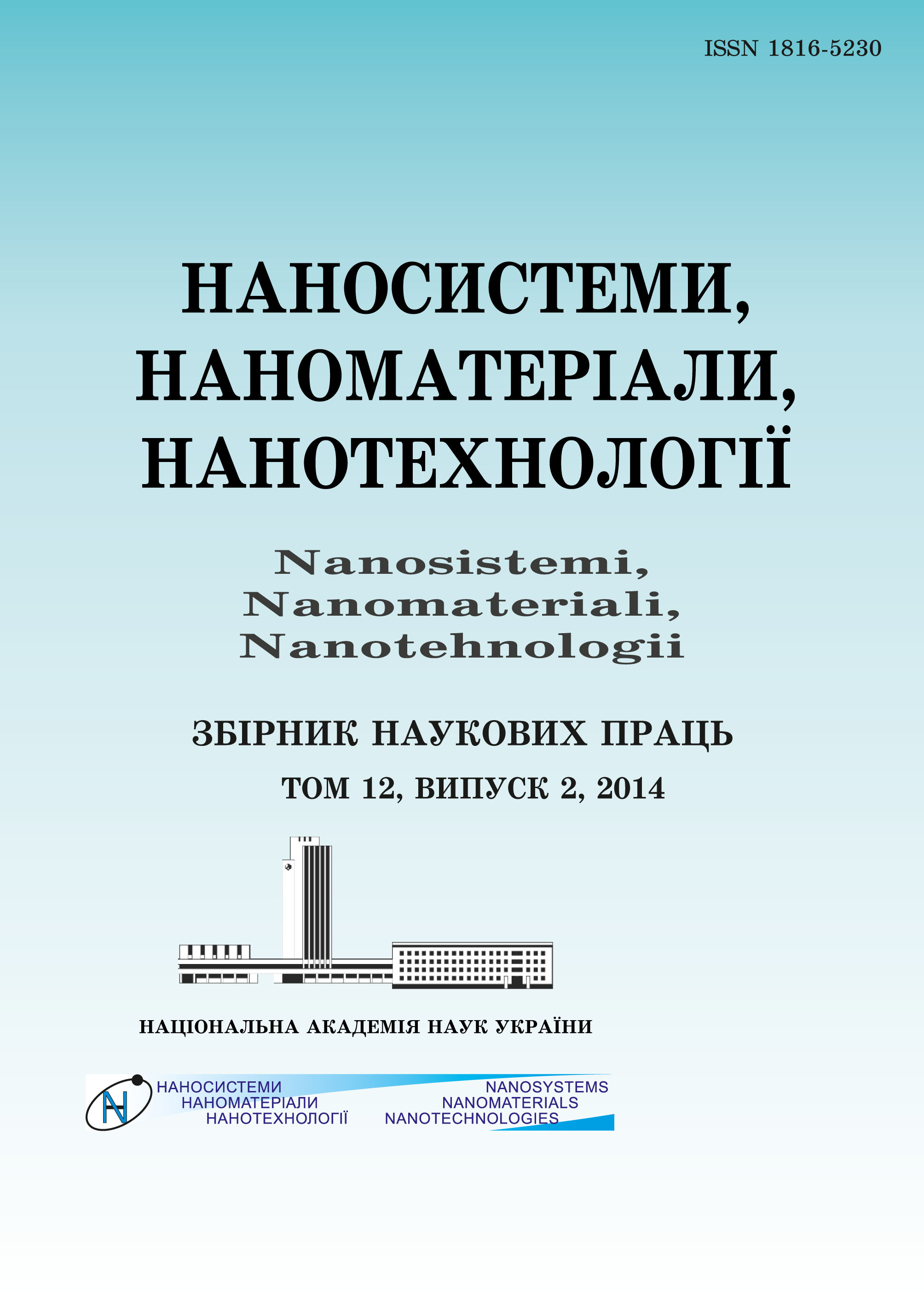|
|
|||||||||

|
Year 2025 Volume 23, Issue 2 |
|
|||||||
|
|||||||||
Issues/2025/vol. 23 /issue 2 |
|
F. M. BUKHANKO
Donetsk Institute for Physics and Engineering named after O. O. Galkin, N.A.S. of Ukraine, 46, Nauky Ave., UA-03028 Kyiv, Ukraine
Creating of Bounded Majorana Pairs in Superconducting Net of Quantum Nanowires in SmMnO3+δ
423–435 (2025)
PACS numbers: 73.63.Nm, 74.78.Na, 75.30.Fv, 75.47.Lx, 75.60.Ej, 81.07.Vb, 85.35.Be
In this work, the formation of a superconducting network of quantum nanowires in SmMnO3+δ manganites in two hidden topological states CSL1 and CSL2 of a chiral quantum spin liquid is experimentally studied. As believed, the states of bound pairs of Majorana fermions are trapped at the two ends of the quantum nanowire. The formation of nanofragments of 1D coupled charge and spin densities' waves with wave vectors q1||a and q2||b as regards directions in the crystal lattice within the magnetic fields H ≥ 100 Oe indicates formation in ab planes of 2D quantum-nanowires' net. Within the weak magnetic fields H = 100 Oe, 350 Oe and 1 kOe, the continuous spectrum of the thermal excitations of bounded Majorana pairs in SmMnO3+δ in temperature interval of 4.2–12 K is divided into two low-energy Landau zones with numbers n = 1 and n = 2 with two specific features of magnetization M(T) in the shape of alternating double peaks and truncated Dirac cones.
KEY WORDS: Majorana and Dirac fermions, alternating double peaks and truncated Dirac cones, chiral quantum spin liquid
DOI: https://doi.org/10.15407/nnn.23.02.0423
REFERENCES
- N. Read and D. Green, Phys. Rev. B, 61, Iss. 15: 10267 (2000); https://doi.org/10.1103/PhysRevB.61.10267
- J. D. Sau, R. M. Lutchyn, S. Tewari, and S. Das Sarma, Phys. Rev. Lett., 104, Iss. 4: 040502 (2010); https://doi.org/10.1103/PhysRevLett.104.040502
- J. D. Sau, S. R. Tewari, R. M. Lutchyn, T. D. Stanescu, and S. Das Sarma, Phys. Rev. B, 82, Iss. 21: 214509 (2010); https://doi.org/10.1103/PhysRevB.82.214509
- M. Leijnse and K. Flensberg, arXiv:1107.5703v2 [cond-mat.supr-con] 30 Nov 2011.
- Y. Oreg, G. Refael, and F. V. Oppen, Phys. Rev. Lett., 105, Iss. 17: 177002 (2010); https://doi.org/10.1103/PhysRevLett.105.177002
- S. Tewari and J. D. Sau, Phys. Rev. Lett., 109, Iss. 15: 150408 (2012); https://doi.org/10.1103/PhysRevLett.109.150408
- J. D. Sau, S. Tewari, and S. Das Sarma, arXiv:1111.2054v3 [cond-mat.supr-con] 27 Feb 2012.
- T. P. Choy, J. M. Edge, J. M. Akhmerov, and C. W. J. Beenakker, arXiv:1108.0419v1 [cond-mat.mes-hall] 1 Aug 2011.
- I. Martin and A. F. Morpurgo, arXiv:1110.5637v2 [cond-mat.mes-hall] 29 Mar 2012.
- W. DeGottardi and D. Sen, arXiv:1208.0015v1 [cond-mat.str-el] 31 Jul 2012.
- F. Wilczek, Nature Phys., 5, Iss. 5: 614 (2009); https://doi.org/10.1038/nphys1380
- K. Pakrouski, M. R. Peterson, T. Jolicoeur, V. W. Scarola, C. Nayak, and M. Troyer, Phys. Rev. X, 5, Iss. 4: 021004 (2015); doi:10.1103/PhysRevX.5.021004
- A. Kitaev, Ann. Phys., 303, Iss. 1: 2 (2003); https://doi.org/10.1016/S0003-4916(02)00018-0
- C. Nayak, S. H. Simon, A. Stern, M. Freedman, and S. Das Sarma, Rev. Mod. Phys., 80, Iss. 3: 1083 (2008); https://doi.org/10.1103/RevModPhys.80.1083
- J. Alicea, Y. Oreg, G. Refael, F. von Oppen, and M. P. A. Fisher, Nature Physics, 7, Iss. 2: 412 (2011); http://dx.doi.org/10.1038/nphys1915
- J. D. Sau, S. Tewari, R. Lutchyn, T. Stanescu, and S. Das Sarma, arXiv:1006.2829v2 [cond-mat.supr-con] 30 Jun 2010.
- R. M. Lutchyn, T. D. Stanescu, and S. Das Sarm, Phys. Rev. Lett., 106, Iss. 12: 127001 (2011); https://doi.org/10.1103/PhysRevLett.106.127001
- H. Tian, S. Che, T. Xu, P. Cheung, K. Watanabe, T. Taniguchi, M. Randeria, F. Zhang, C. N. Lau, and M. W. Bockrath, arXiv 2112.13401 [cond-mat.supr-cond] 2021.
- S. Peotta and P. Tormä, arXiv:1506.02815v3 [cond-mat.supr-con] 2 Dec 2015.
- X. Hu, T. Hyart, D. I. Pikulin, and E. Rossi, Phys. Rev. Lett., 123, Iss. 23: 237002 (2019); https://doi.org/10.1103/PhysRevLett.123.237002
- F. Xie, Z. Song, B. Lian, and B. A. Bernevig, Phys. Rev. Lett., 124, Iss. 16: 167002 (2020); https://doi.org/10.1103/PhysRevLett.124.167002
- A. Julku, T. J. Peltonen, L. Liang, T. T. Heikkilä, and P. Törmä, Phys. Rev. B, 101, Iss. 6: 060505 (2020); https://doi.org/10.1103/PhysRevB.101.060505
- N. Verma, T. Hazra, and M. Randeria, Proc. Nat. Acad. Sci., 118, Iss. 8: e2106744118 (2021); https://doi.org/10.1073/pnas.2106744118
- Q. Chen, J. Stajic, S. Tan, and K. Levin, Physics Reports, 412, Iss. 1: 1 (2005); https://doi.org/10.1016/j.physrep.2005.02.005
- M. Randeria and E. Taylor, Annual Reviews of Condensed Matter Physics, 5, Iss. 3: 209 (2014); https://doi.org/10.1146/annurev-conmatphys-031113-1338299
- Y. Nakagawa, Y. Kasahara, T. Nomoto, R. Arita, T. Nojima, and Y. Iwasa, Science, 372, Iss. 4: 190 (2021); doi:10.1126/science.abb9860
- T. T. Heikkilä and G. E. Volovik, Basic Physics of Functionalized Graphite, 123, Iss. 7: 123 (2016); https://doi.org/10.1007/978-3-319-39355-1_6
- V. J. Kauppila, F. Aikebaier, and T. T. Heikkilä, Phys. Rev. B, 93, Iss. 6: 214505 (2016); https://doi.org/10.1103/PhysRevB.93.214505
- M. Sato and Y. Ando, Rep. Prog. Phys., 80, Iss. 7: 076501 (2017); https://doi.org/10.1088/1361-6633/aa6ac7
- K. T. Law, P. A. Lee, and T. K. Ng, Phys. Rev. Lett., 103, Iss. 23: 237001 (2009); https://doi.org/10.1103/PhysRevLett.103.237001
- K. Flensberg, Phys. Rev. B, 82, Iss. 18: 180516 (2010); https://doi.org/10.1103/PhysRevB.82.180516
- P. A. Ioselevich and M. V. Feigel’man, New J. Phys., 15, Iss. 5: 055011 (2013); https://doi.org/10.1088/1367-2630/15/5/055011
- L. Balents, C. R. Dean , D. K. Efetov, and A. F. Young , Nature Physics, 16, Iss. 5: 725 (2020); https://doi.org/10.1038/s41567-020-0906-9
- A. Kitaev, Annals of Physics, 321, Iss. 6: 2 (2006); https://doi.org/10.1016/j.aop.2005.10.005
- H. Yao and S. A. Kivelson, Phys. Rev. Lett., 99, Iss. 24: 247203 (2007); https://doi.org/10.1103/PhysRevLett.99.247203
- F. N. Bukhanko and A. F. Bukhanko, Physics of the Solid State, 61, Iss. 12: 2525 (2019); doi:10.1134/S1063783419120084
- F. N. Bukhanko and A. F. Bukhanko, Fiz. Nizk. Temp., 47, Iss. 11: 1021 (2021); doi:10.1063/10.0006569
 This article is licensed under the Creative Commons Attribution-NoDerivatives 4.0 International License ©2003 NANOSISTEMI, NANOMATERIALI, NANOTEHNOLOGII G. V. Kurdyumov Institute for Metal Physics of the National Academy of Sciences of Ukraine. E-mail: tatar@imp.kiev.ua Phones and address of the editorial office About the collection User agreement |